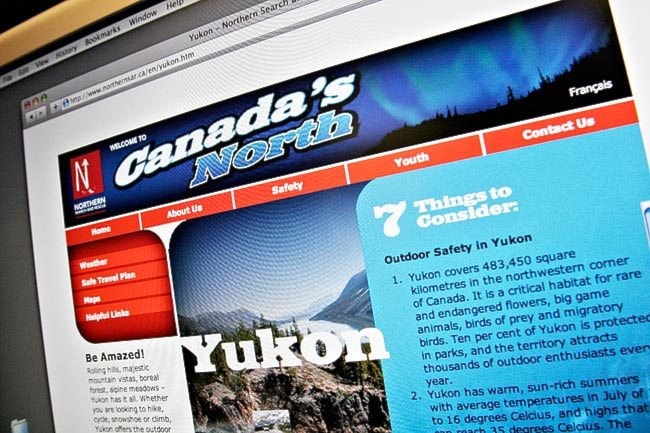A new search-and-rescue website for Canada’s North reminds readers that if they get cold, they should head indoors.
It also claims it’s more important to carry a GPS and satellite phone on a short snowmobile jaunt than it is to bring a supply of food and water.
The advice is not meant for outdoor enthusiasts, said Yukon Emergency Measures manager Michael Templeton.
“It’s basic tips for tourists,” he said.
“We want to get this information out there as people are planning their trips.”
Another section of the website suggests if you’re backcountry skiing and notice white patches on your friend’s face it’s best to get them indoors, rather than build a fire.
“A lot of regular campers are going to think, ‘Duh, I already know this,’” said Templeton.
But the website’s recommendations don’t jive with accepted outdoor lore.
For one, advising day trippers to stick a GPS and satellite phone in their pack before food and water undermines the basic tenets of outdoor survival.
And to recommend a person suffering from hyperthermia or frostbite is best to head indoors oversimplifies wilderness scenarios, where a quick fire could, in fact, be the best choice to immediately raise someone’s body temperature.
The search-and-rescue website is divided into three sections, the Yukon, the NWT and Nunavut, and is available in English, French and Inuktitut.
General enough to cover all the territories, it offers up some pretty simple advice - if lost, stay put; if cold, warm up; to avoid bears, eliminate food odours; and if stranded use the car heater to stay warm, but don’t die from carbon monoxide poisoning.
There is also weather and map sections that link to weather websites and a Canada atlas website, respectively.
The Yukon’s search-and-rescue website is an “important new resource that will not only help Yukoners stay safe, but will help visitors to Yukon’s world-class wilderness areas better prepare themselves for the conditions they may face when venturing into our backcountry,” said Tourism and Culture Minister Elaine Taylor in a release this week.
But the Yukon’s main tourism website, Larger than Life, already covers most of the same information in more detail, has its own maps and weather sections and has more in-depth information on bear safety to boot.
The BC travel site BCadventure.com is even better, putting the Yukon’s new website to shame. BCadventure.com’s wilderness-survival-skills section deals with everything from pain and fear to the psychological dangers of boredom and loneliness when lost in the wilds. And its “how to” section gives readers advice and diagrams on how to build a fire using everything from nail polish to gun powder, and how to make various survival shelters out of bark, grass, plastic and snow.
On the Yukon’s new search-and-rescue site, the only advice offered on building fires is to carry matches and, in terms of shelter, it recommends setting up a tent or getting in a vehicle if a warm house is not immediately available.
Templeton admits it’s basic.
“It’s not meant to be a learning tool,” he said.
“We kept it general so it stayed a small site and didn’t use much bandwidth.”
The site is part of a three-year federal initiative worth $851,000, with the territory chipping in 10 per cent.
The money has also been used to educate youth, create a newsletter for First Nation communities and to educate search-and-rescue teams and make a training manual.
The website’s best feature is its safe travel plan PDFs, one called the “overnighter,” and the other called the “daytripper.” The fill-in-the-blank forms are supposed to be e-mailed or left with a friend, and include the trip itinerary, who’s in the party, license numbers and where the group is headed.
“So many of us know we should do this, but don’t,” said Templeton. Even heading out for a day of mountain biking, it’s a good idea to let someone know your plans, he said.
The new site links to the RCMP, which supports the initiative and to tourism websites, including the Yukon’s Larger than Life site.
And Templeton hopes people will link from the Larger than Life site to the search-and-rescue page as well.
But the Tourism Department doesn’t have the link set up in a very obvious spot.
“Right now it’s not easy to find,” said Tourism spokesperson Karen Keeley. “We will be following up to make it more user friendly.”
To visit the site go to www.northernsar.ca.
Contact Genesee Keevil at
gkeevil@yukon-news.com
